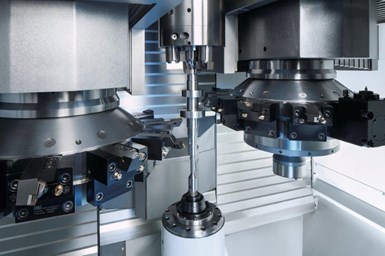EMAG 4-Axes Lathes Deliver Optimized Performance
The lathes are said to provide short cycle times, high-precision machining and safe processing with the VT series of turning machines literally turning the classic horizontal machining process on its head.
Share





The dual tool turrets of VT Series lathes, each with 11 stations (all of which can be equipped with turning tools along with driven tools), are said to guarantee flexibility. Photo Credit: EMAG
EMAG’s VT 2 and VT 4 lathes are said to provide not only precise and efficient machining, but their integrated loading and unloading systems also deliver optimum speed and performance. With short cycle times, high-precision machining and safe processing, the turning machines of the VT series are said to literally turn the classic horizontal machining process on its head.
In addition to employing four axes, short travels and a powerful main spindle, these modular lathes are twin-sided, enabling large batch components to be manufactured quickly. The dual tool turrets — each with 11 stations, all of which can be equipped with turning tools along with driven tools — are said to guarantee flexibility. Automation is fully integrated on these lathes. The turret loads and unloads work pieces into the machining area. While one gripper, occupying the twelfth position of the turret, conveys a new raw part into the machine, the other removes the finished component. The loading process can take as little as six seconds, depending on the workpiece.
The VT 2 can handle workpiece diameters up to 4" (100 mm) and lengths up to 15.5" (400 mm). The VT 4 accepts shafts up to 8" (200 mm) in diameter and up to 25" (630 mm) long.
Advantages of the VT series include shorter cycle times through four-axes machining, less expense for automation and peripherals and reduced idle times through cycle time-concurrent loading and unloading, the company says. The machine can be used as a stand-alone or in a production line. Easily accessible and operator-friendly workpiece areas mean short setting and resetting times. And less operator intervention because tailstock and steady are CN-controlled, and turrets can be accessed directly.
The company says the vertical construction of the machine and the resulting free chip flow prevent the creation of chip clusters. Raw part and finished component storage are said to form an integral part of the machine.
Related Content
-
4 Tips for Staying Profitable in the Face of Change
After more than 40 years in business, this shop has learned how to adapt to stay profitable.
-
3 Tips to Accelerate Production on Swiss Lathes with Micro Tools
Low RPM lathes can cause tool breakage and prevent you from achieving proper SFM, but live tooling can provide an economical solution for these problems that can accelerate production.
-
Top Shops: Designing a Shop to Meet Customer Needs
Working closely with customers and making careful investments has enabled this Wisconsin machine shop to tackle difficult jobs with tight deadlines as a core part of its business.


















.jpg;maxWidth=300;quality=90)






